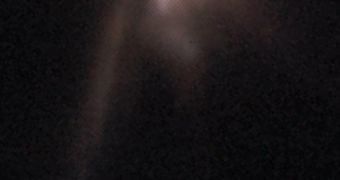Astronomers have been debating whether the body known as TMR-1C is an exoplanet or a star for many years, but now two new studies appear to have finally ended the controversy.
Back in 1998, experts snapped an interesting picture of this mysterious cosmic object, and a group of experts proposed that this was the first time an exoplanet had been imaged directly.
But subsequent studies argued that the object was in fact a smaller star, and that the first exoplanet had yet to receive a direct photo shoot.
The first investigations of TMR-1C were conducted using the Hubble Space Telescope, which saw the object as lying at the end of a luminous filament emanating from two newly-born stars.
This made astronomers believe that the planet had been cast out by the forming stars. But many experts were skeptical, arguing that the white dot of light may have very well been another new star.
In two separate studies, which are scheduled to be published in an upcoming issue of the esteemed scientific journal Astronomy & Astrophysics, researchers now argue that the first assumption NASA made when analyzing the Hubble images was the correct one, and add that the 1998 photo is indeed the first direct image of an exoplanet.
“We may have to credit [Susan] Terebey [now at the California State University] et al with finding a planet after all, but it is perhaps too soon to jump to that conclusion, just as it was too soon to discard the object as a planet 10 years ago,” says Eduardo Martin.
He is based in Madrid, Spain, at the Centro de Astrobiologia, and is also a coauthor of one of the two new research papers, Science News reports.
“This object should be reconsidered as a planet candidate,” the expert adds, saying that Terebey's initial assessments and calculations appear to have been correct.
The Spanish team says that the differences in brightness and luminosity may have been caused by the object moving in or out of its massive cosmic dust envelope.
But not everyone agrees with the new conclusions. “I'm not convinced by either study. This is a very faint and difficult-to-observe object,” says NASA Ames Research Center expert Mark Marley.
Follow me on Twitter @TudorVieru

 14 DAY TRIAL //
14 DAY TRIAL //